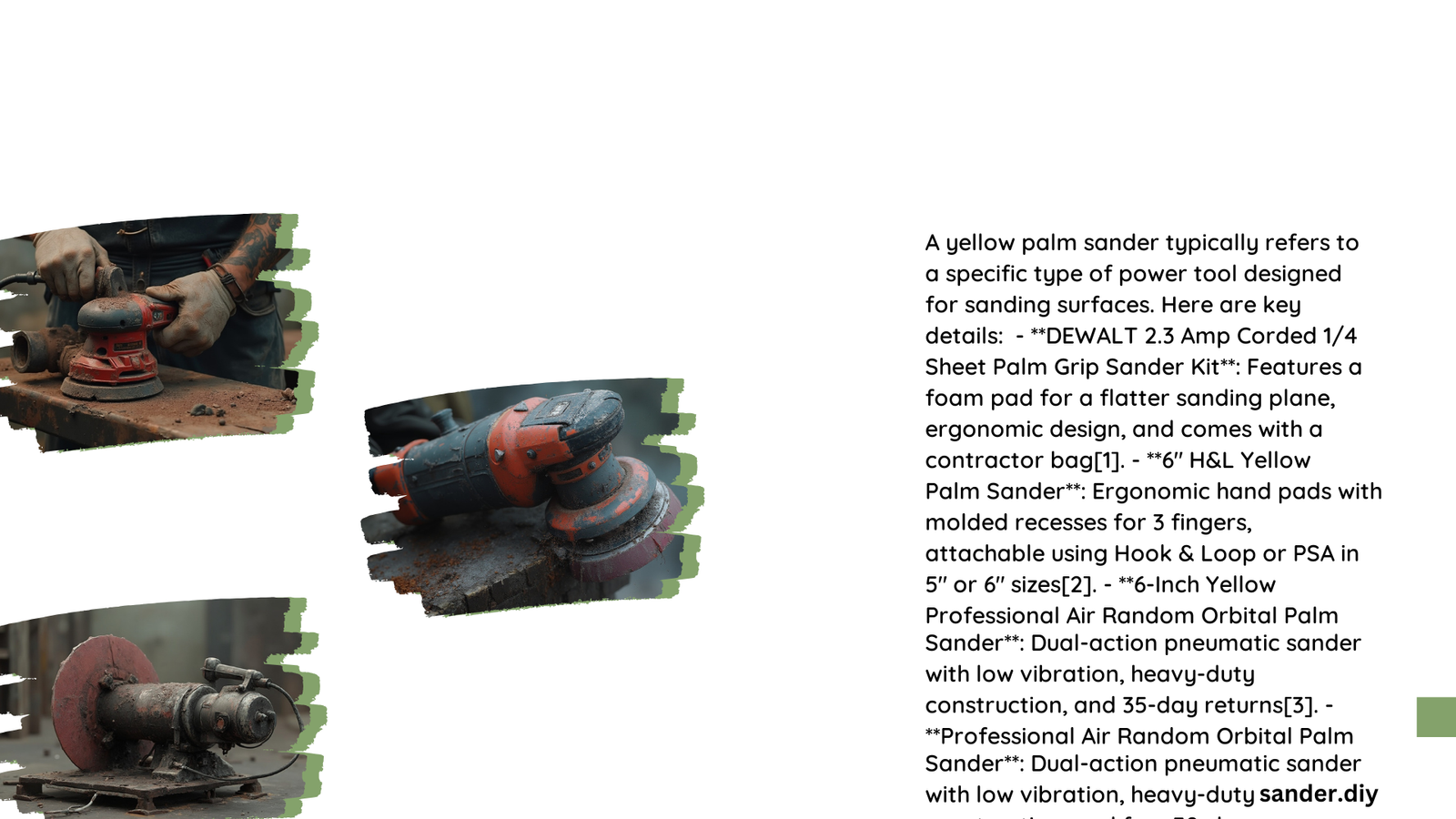Yellow palm sanders are compact, handheld power tools designed for smooth and efficient sanding of various materials. These versatile devices typically feature a vibrating pad that holds sandpaper, allowing users to achieve fine finishes on wood, metal, and other surfaces. With their ergonomic design and powerful motors, yellow palm sanders are popular among both DIY enthusiasts and professional woodworkers for their ease of use and consistent results.
What are the Key Features of a Yellow Palm Sander?
Yellow palm sanders are characterized by several important features:
- Compact size for easy maneuverability
- Ergonomic design for comfortable grip
- Vibrating pad mechanism for smooth sanding
- Dust collection system for cleaner work environments
- Variable speed settings (in some models)
- Compatibility with various sandpaper grits
These features contribute to the tool’s efficiency and user-friendliness, making it a popular choice for a wide range of sanding tasks.
How Does a Yellow Palm Sander Compare to Other Sander Types?

When comparing yellow palm sanders to other sander types, several factors come into play:
| Sander Type | Advantages | Disadvantages |
|---|---|---|
| Yellow Palm Sander | – Compact and lightweight – Easy to control – Ideal for detailed work |
– Limited power for large surfaces – May leave swirl marks |
| Random Orbital Sander | – Efficient material removal – Leaves fewer swirl marks |
– More expensive – Heavier than palm sanders |
| Belt Sander | – Powerful for large surfaces – Fast material removal |
– Difficult to control – Not suitable for detailed work |
| Drum Sander | – Ideal for hardwood floors – Consistent results on large areas |
– Expensive – Requires skill to operate |
Yellow palm sanders excel in tasks requiring precision and control, making them ideal for furniture refinishing, trim work, and other detail-oriented projects.
What are the Best Practices for Using a Yellow Palm Sander?
To achieve optimal results with a yellow palm sander, follow these best practices:
- Choose the right grit: Start with coarse grit for material removal, then progress to finer grits for smooth finishes.
- Apply even pressure: Let the sander’s weight do the work; avoid pressing too hard.
- Move in overlapping patterns: Ensure consistent coverage of the surface.
- Keep the sander flat: Tilting can create uneven surfaces or gouges.
- Use dust collection: Connect a vacuum or dust bag to minimize airborne particles.
- Maintain steady movement: Avoid leaving the sander in one spot to prevent over-sanding.
How to Select the Right Sandpaper for a Yellow Palm Sander?
Choosing the appropriate sandpaper is crucial for effective sanding. Consider the following factors:
- Grit size: Lower numbers (60-80) for coarse sanding, higher numbers (220+) for fine finishing
- Material: Aluminum oxide for general purpose, silicon carbide for harder materials
- Backing: Paper-backed for general use, cloth-backed for durability
- Attachment method: Hook-and-loop or adhesive-backed, depending on your sander model
Match the sandpaper to your specific task and material for the best results.
What Maintenance is Required for a Yellow Palm Sander?
Regular maintenance ensures the longevity and performance of your yellow palm sander:
- Clean dust and debris after each use
- Check and replace worn sandpaper
- Inspect the power cord for damage
- Lubricate moving parts as recommended by the manufacturer
- Empty or clean the dust collection system regularly
- Store in a dry, clean environment
Proper maintenance will extend the life of your tool and ensure consistent performance.
How to Troubleshoot Common Yellow Palm Sander Issues?
If you encounter problems with your yellow palm sander, try these troubleshooting steps:
- Sander won’t start:
- Check power connection
- Inspect switch for damage
-
Verify brush condition in corded models
-
Excessive vibration:
- Ensure sandpaper is properly attached
- Check for loose components
-
Inspect the pad for damage
-
Poor dust collection:
- Clean or replace dust bag
- Check for clogs in the dust port
-
Ensure proper seal between sander and dust collection system
-
Uneven sanding:
- Replace worn or damaged sanding pad
- Use consistent pressure and movement
- Ensure sandpaper is flat and properly attached
By addressing these common issues, you can maintain the efficiency and effectiveness of your yellow palm sander.
What Safety Precautions Should be Taken When Using a Yellow Palm Sander?
Safety is paramount when operating any power tool. Follow these precautions:
- Wear safety glasses to protect your eyes from dust and debris
- Use a dust mask to avoid inhaling fine particles
- Wear hearing protection for extended use
- Ensure proper ventilation in your work area
- Disconnect the power source before changing sandpaper or performing maintenance
- Keep hands away from the sanding pad during operation
- Secure loose clothing and tie back long hair
Adhering to these safety measures will help prevent accidents and protect your health while using a yellow palm sander.
Yellow palm sanders are versatile tools that, when used correctly, can provide excellent results for a variety of sanding tasks. By understanding their features, proper use, and maintenance requirements, you can make the most of this efficient sanding tool in your woodworking or DIY projects.
References:
1. 1/4 Sheet Palm Sander Reviews | Finish – Woodworker’s Journal
2. Best corded Random Orbital Sander? – GON Forum
3. 6\” H&L YELLOW PALM SANDER
